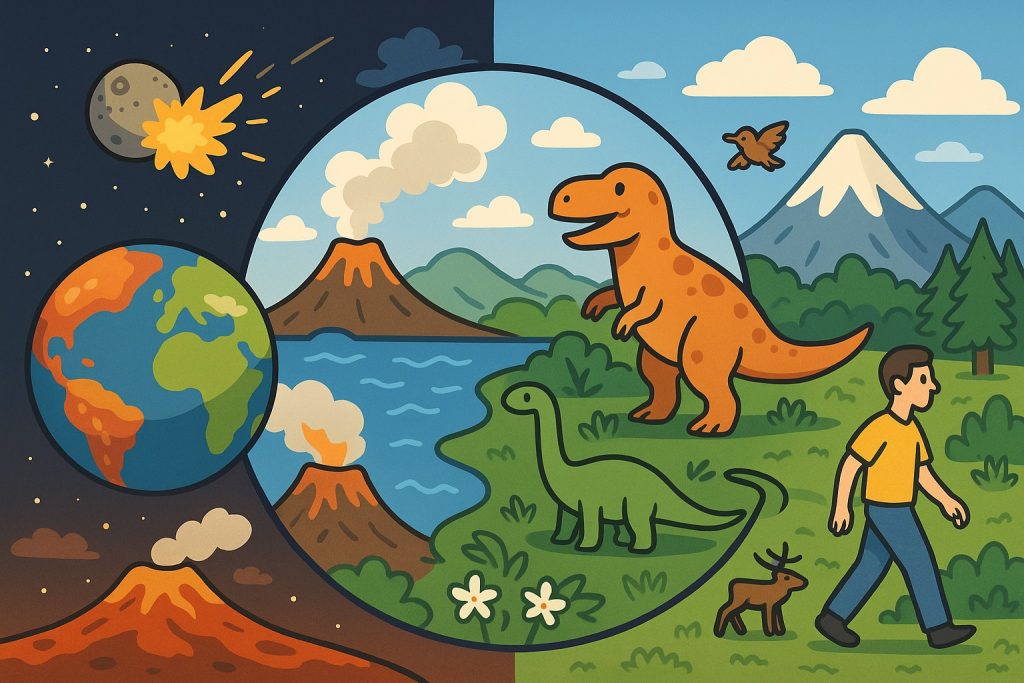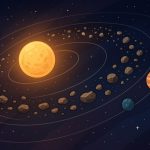The history of planet Earth spans over 4.5 billion years, from a chaotic ball of molten rock to a thriving world of oceans, forests, and intelligent life. Earth’s story is written in its rocks, fossils, and the changing atmosphere, shaped by natural forces and—more recently—by human activity.
Formation of the Planet (~4.6 Billion Years Ago)
Earth formed from the solar nebula, a swirling cloud of gas and dust left over after the birth of the Sun. Gravity pulled material together into a planetesimal, which grew through collisions into a proto-Earth. Intense heat from impacts, radioactive decay, and pressure melted the planet, allowing heavier elements like iron and nickel to sink to the center, forming the core, while lighter materials formed the mantle and crust.
During this period, a Mars-sized object likely collided with Earth, ejecting debris that later formed the Moon.
The Hadean and Archean Eons: Earth Takes Shape (4.6–2.5 Billion Years Ago)
The early Earth was molten, volcanic, and hostile. Eventually, the surface cooled enough to allow water vapor to condense into oceans. Life may have begun as early as 3.8 billion years ago, in the form of simple prokaryotic microbes, possibly around hydrothermal vents on the ocean floor.
Cyanobacteria—early photosynthesizing organisms—began producing oxygen, paving the way for major atmospheric changes.
The Great Oxidation Event (~2.4 Billion Years Ago)
As photosynthetic microbes spread, oxygen built up in Earth’s atmosphere. This triggered a major shift in global chemistry and led to the first mass extinction—of anaerobic organisms that couldn’t survive in oxygen-rich environments. This period marked the beginning of the Proterozoic Eon.
Rise of Complex Life (600–540 Million Years Ago)
Multicellular life appeared in the oceans. The Ediacaran biota were among the first large organisms, but most went extinct before the Cambrian Explosion, a sudden burst of biodiversity around 541 million years ago that introduced almost all major animal groups.
Life Moves to Land (500–250 Million Years Ago)
In the Paleozoic Era, plants, insects, and eventually vertebrates began colonizing land. Massive forests formed, and continents drifted into a supercontinent called Pangaea.
The era ended with the Permian extinction—the largest in Earth’s history—which wiped out over 90% of marine species and 70% of terrestrial ones.
The Age of Dinosaurs (250–66 Million Years Ago)
The Mesozoic Era saw the rise of reptiles, including dinosaurs, as well as the first birds and flowering plants. It ended with a mass extinction, likely caused by an asteroid impact near modern-day Mexico, which eliminated the dinosaurs (except birds) and many other species.
The Age of Mammals and Humans (66 Million Years Ago – Present)
The Cenozoic Era witnessed the rise of mammals, eventually leading to primates and early humans. Around 2 million years ago, the genus Homo emerged. Homo sapiens, our species, evolved around 300,000 years ago in Africa.
Human civilization began roughly 10,000 years ago, with agriculture, cities, and technology rapidly transforming Earth’s surface and atmosphere.
Earth Today and Tomorrow
Now in the Anthropocene (a proposed epoch), human activity is the dominant force shaping Earth’s systems. From climate change and deforestation to space exploration and AI, our actions are leaving permanent marks on the planet.
Understanding Earth’s history helps us see our place in the broader story—and the responsibility we hold for its future.
Glossary
- Solar nebula — A cloud of gas and dust from which the Sun and planets formed.
- Prokaryote — A single-celled organism without a nucleus, like bacteria.
- Cyanobacteria — Microorganisms that perform photosynthesis and helped create Earth’s oxygen atmosphere.
- Cambrian Explosion — A period of rapid evolutionary diversification around 541 million years ago.
- Pangaea — A supercontinent that existed before the continents split.
- Anthropocene — A proposed epoch marking the dominant impact of humans on Earth’s geology and ecosystems.


